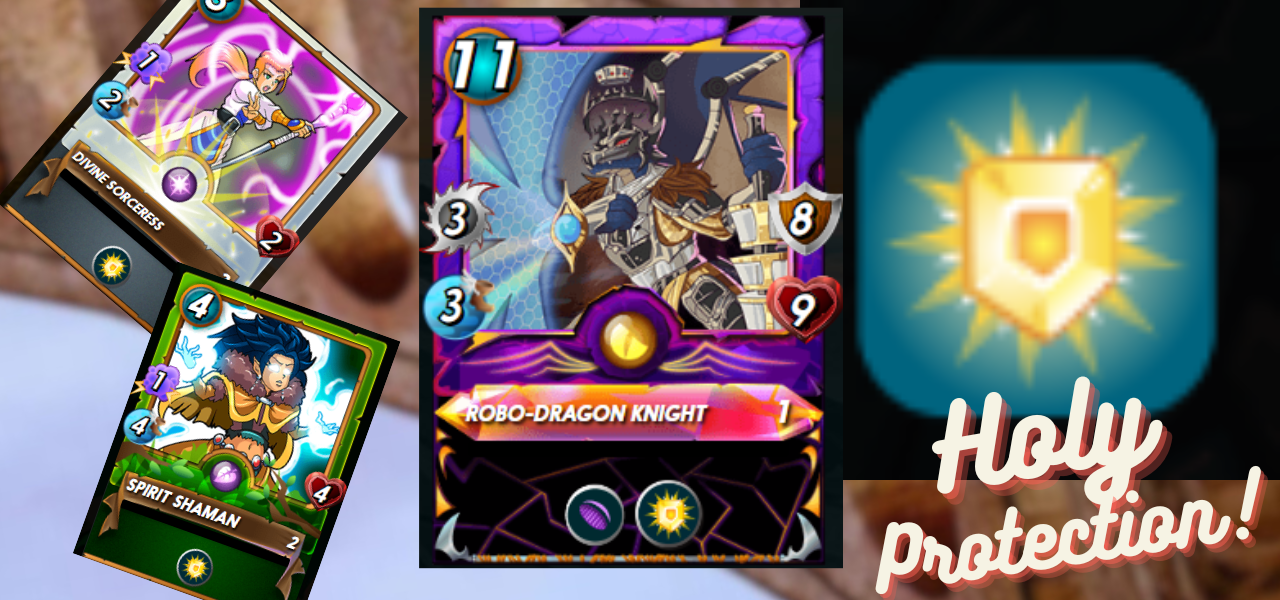In the world of splinterlands, countless strategies and techniques have been developed over the ages to gain an advantage on the battlefield. Among these methods stands an ancient and enigmatic practice known as "Holy Protection." Rooted in the intertwining realms of spirituality and martial prowess, this sacred art is believed to bestow its practitioners with an extraordinary shield against harm and danger. In this blog, we will embark on a journey to unravel the mysteries surrounding Holy Protection, exploring its principles, and significance in the art of combat.
The Principles of Holy Protection:
The Principles of Holy Protection bestow a profound and sacred ability upon all creatures engaged in battle: the esteemed Divine Shield. This extraordinary gift grants exceptional protection, serving as an impregnable barrier against harm and malevolence. However, it is crucial to understand the specific implications of this powerful rule.
Those creatures that inherently possess the Divine Shield ability shall not experience any direct advantage from the rule of Holy Protection. Instead, the focus of this extraordinary principle is on those beings lacking this innate defense, who shall receive its immense benefits when invoked.

Central to the doctrine of Holy Protection is an unwavering belief in a higher power or divine entity. This transcendent force is believed to be ever-watchful, offering its benevolent guardianship to those who earnestly seek its shelter. To access the Divine Shield, combatants must establish a profound connection with this higher realm, achieved through unwavering faith, introspective meditation, or heartfelt prayer.
The Techniques of Holy Protection:
The Holy Protection combat rule is remarkably straightforward, yet highly effective. It bestows upon the monsters an additional ability known as the "Divine Shield." This newfound ability becomes a pivotal asset during battles, offering an unparalleled advantage to those who possess it. As long as a monster wields the Divine Shield, no strikes or attacks can inflict any harm upon its health. This remarkable capability even renders the most potent and formidable magical assaults utterly ineffectual against the monster's well-protected defenses. In essence, the Divine Shield acts as an impregnable barrier, ensuring that the monsters remain impervious to harm, thereby dramatically enhancing their survivability and combat prowess on the battlefield.
.gif)
The Significance of Holy Protection in Combat:
Beyond its mystical allure, Holy Protection holds profound significance in the realm of combat. In the face of danger and uncertainty, it serves as a source of courage and confidence for warriors. The belief in divine guardianship can bolster their resolve, allowing them to face formidable foes with unshakable determination.
Moreover, Holy Protection is not solely confined to physical defense. It also addresses the mental and emotional aspects of combat. By cultivating inner peace and spiritual strength, practitioners gain resilience against fear, doubt, and despair, which are just as formidable adversaries as any physical foe.

The Legacy of Holy Protection:
Throughout history, there have been countless tales of warriors who credited their survival and triumphs to the intervention of divine protection. These stories have inspired generations of combatants, perpetuating the legacy of Holy Protection as an essential aspect of the warrior's journey.
While skepticism may persist, the allure of the sacred guardian endures. As long as there are battles to be fought, the desire for an invincible shield against harm will remain a potent force in the hearts of warriors across the ages.


The combat rule has a significant impact on the battle, causing more problems than the mana limit alone. In this particular battle, the mana restriction was exceptionally low, set at a mere 21. This limitation made the situation even more challenging since only the Life Source monsters were allowed to participate in the fight. Consequently, I faced considerable difficulty in choosing the right warrior to engage in this combat under such stringent conditions.
.gif)
.gif)
In this battle, I employed a straightforward yet effective strategy. Given the low mana cost of only 21, I anticipated that my opponent would likely be unable to summon a highly damaging monster. To capitalize on this advantage, I strategically chose to deploy one of my life monsters, the Shieldbearer, known for its Taunt ability. This ability is remarkable as it draws the attacks of all the opposing team's monsters towards itself, effectively becoming the primary target for their assaults.
By using the Shieldbearer's Taunt ability, I ensured that the rest of my team's monsters remained unharmed as long as the Shieldbearer was still alive. As expected, all the opponent's monsters capable of launching attacks started directing their strikes toward the Shieldbearer due to the compelling lure of its Taunt ability. This tactical decision allowed my other monsters to maintain their health and remain in a more advantageous position, ultimately giving us a higher chance of emerging victorious in the battle.

.gif)
The critical aspect of this strategy revolves around ensuring the longevity of the Shieldbearer in the battle. It's essential to keep the Shieldbearer alive as long as possible to maintain a strong defensive advantage. To achieve this, I carefully selected three supporting monsters to complement the Shieldbearer's abilities.
The first supporting monster in my team is Venari Crystalsmith, equipped with the Tank Heal ability. This creature plays a crucial role in the strategy by providing healing of up to 3 health points in a single round. With its assistance, the Shieldbearer can recover from any damage sustained during the battle, effectively prolonging its survival.
The second supporting monster is Armorsmith, possessing the Repair ability. This skill allows the Armorsmith to mend up to 2 points of damaged armor. As the opponents' monsters were targeting the Shieldbearer's armor with their attacks, the Armorsmith quickly stepped in to repair the damage inflicted, bolstering the Shieldbearer's defenses.
The third supporting monster is the Divine Healer, which, like Venari Crystalsmith, boasts the Tank Heal ability. Having two monsters with healing capabilities in the team ensures that the Shieldbearer receives ample health restoration, further increasing its resilience during the battle.
Even when facing two opponents' monsters attacking the Shieldbearer's health and two others targeting its armor, their combined efforts proved futile. The two monsters dealing health damage only managed to inflict a total of 3 health points, an amount easily countered and healed by Venari CRYSTALSMITH in each round. Meanwhile, the Armorsmith diligently repaired any damage to the Shieldbearer's armor, ensuring that it remained unharmed and impervious to harm.
Thanks to the impeccable synergy between the Shieldbearer and the three supporting monsters, it successfully withstood the relentless attacks from the opposing team. The Shieldbearer emerged from each round unscathed, and its tenacity, combined with the support from its allies, ultimately played a pivotal role in securing victory in the battle.
.gif)
.gif)
However, the opponent made a critical mistake by not including any monsters in their lineup that could heal their own team or repair their damaged armor. This oversight proved to be detrimental for their team as the battle progressed. The opposing team's monsters dealt more damage compared to mine, with the opponent's monsters capable of inflicting around 6 points of damage per attack, while my team's monsters could only deal 3 points of damage each.
Despite the fact that my monsters weren't inherently stronger than the opponent's, my strategy proved to be the key to victory. Two of my key monsters, the Shieldbearer and the Venari Crystalsmith, played a crucial role. With a well-thought-out plan, they began to eliminate the opposition's monsters one by one.
The Shieldbearer held strong, acting as a stalwart protector for my team, mitigating incoming damage and providing a shield against powerful attacks. Meanwhile, the Venari Crystalsmith exhibited remarkable skills in dismantling the opposition's monsters with its precision attacks, exploiting their vulnerabilities.
As the battle unfolded, it became evident that my strategic approach was overpowering the raw strength of the opponent's monsters. With each passing turn, my team's relentless assault and defensive tactics were wearing down the opponent's forces.
The opponent's monsters were unable to withstand the combined might of the Shieldbearer and the Venari Crystalsmith. Slowly but steadily, the opposing team's monsters succumbed to the overwhelming onslaught. Despite their attempts to retaliate, they could not match the coordination and synergy exhibited by my team.
As the last of the opponent's monsters fell, victory was finally assured for my team. The precise execution of my strategy, backed by the exceptional abilities of the Shieldbearer and the Venari Crystalsmith, had brought me triumph in the face of seemingly superior adversaries. The intense battle had been won, a testament to the power of skillful tactics in the ever-evolving world of monster combat.
.gif)
In Conclusion:
Holy Protection, as a combat rule, stands as a testament to the profound connection between spirituality and the art of warfare. Its principles, techniques, and significance continue to captivate the imagination of those who seek a higher purpose in their combative pursuits. Whether it be a symbolic gesture or a tangible force, the belief in divine protection serves as a powerful driving force for those who face the uncertainties of battle. As we journey through the annals of history, reminding us of the timeless quest for safety, strength, and transcendence in the face of adversity.
.jpg)
Tweet:
Thanks for sharing! - @yonilkar
